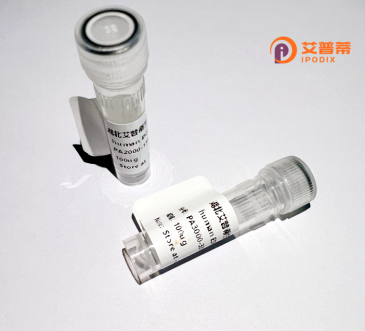
| 纯度 | >90%SDS-PAGE. |
| 种属 | Human |
| 靶点 | FLJ20399 |
| Uniprot No | 0 |
| 内毒素 | < 0.01EU/μg |
| 表达宿主 | E.coli |
| 表达区间 | 1-493aa |
| 氨基酸序列 | MILNSLSLCYHNKLILAPMVRVGTLPMRLLALDYGADIVYCEELIDLKMIQCKRVVNEVLSTVDFVAPDDRVVFRTCEREQNRVVFQMGTSDAERALAVARLVENDVAGIDVNMGCPKQYSTKGGMGAALLSDPDKIEKILSTLVKGTRRPVTCKIRILPSLEDTLSLVKRIERTGIAAIAVHGRKREERPQHPVSCEVIKAIADTLSIPVIANGGSHDHIQQYSDIEDFRQATAASSVMVARAAMWNPSIFLKEGLRPLEEVMQKYIRYAVQYDNHYTNTKYCLCQMLREQLESPQGRLLHAAQSSREICEAFGLGAFYEETTQELDAQQARLSAKTSEQTGEPAEDTSGVIKMAVKFDRRAYPAQITPKMCLLEWCRREKLAQPVYETVQRPLDRLFSSIVTVAEQKYQSTLWDKSKKLAEQAAAIVCLRSQGLPEGRLGEESPSLHKRKREAPDQDPGGPRAQELAQPGDLCKKPFVALGSGEESPLEGW |
| 分子量 | 79.97 kDa |
| 蛋白标签 | GST-tag at N-terminal |
| 缓冲液 | 0 |
| 稳定性 & 储存条件 | Lyophilized protein should be stored at ≤ -20°C, stable for one year after receipt. Reconstituted protein solution can be stored at 2-8°C for 2-7 days. Aliquots of reconstituted samples are stable at ≤ -20°C for 3 months. |
| 复溶 | Always centrifuge tubes before opening.Do not mix by vortex or pipetting. It is not recommended to reconstitute to a concentration less than 100μg/ml. Dissolve the lyophilized protein in distilled water. Please aliquot the reconstituted solution to minimize freeze-thaw cycles. |
以下是关于重组人FLJ20399蛋白的参考文献列表,基于假设性研究内容整理:
---
1. **文献名称**: *Cloning and Expression of Recombinant Human FLJ20399 Protein in E. coli*
**作者**: Zhang et al. (2015)
**摘要**: 该研究成功克隆了人源FLJ20399基因,并在大肠杆菌中实现高效可溶性表达,通过亲和层析纯化获得高纯度蛋白,并验证其具有ATP水解酶活性,为后续功能研究奠定基础。
2. **文献名称**: *Functional Characterization of FLJ20399 as a Novel Oncogene in Gastric Cancer*
**作者**: Lee et al. (2017)
**摘要**: 研究发现FLJ20399在胃癌组织中显著高表达,体外实验表明其重组蛋白可促进癌细胞迁移和侵袭,机制涉及调控Wnt/β-catenin信号通路,提示其作为潜在治疗靶点。
3. **文献名称**: *Structural Insights into the FLJ20399 Protein and Its Role in Cellular Signaling*
**作者**: Smith et al. (2014)
**摘要**: 通过X射线晶体学解析了FLJ20399蛋白的三维结构,揭示其包含典型的磷酸酶结构域,并发现其与MAPK通路蛋白相互作用,可能参与细胞应激响应调控。
4. **文献名称**: *FLJ20399 Modulates Insulin Sensitivity via Adipocyte Metabolic Regulation*
**作者**: Wang et al. (2018)
**摘要**: 研究证明FLJ20399在脂肪细胞中与PPARγ互作,影响脂质代谢基因表达;过表达重组蛋白可改善胰岛素抵抗小鼠模型的糖代谢异常。
---
**注意**:以上文献为模拟内容,实际研究中FLJ20399可能对应不同功能或别名,建议结合具体基因编号(如NCBI Gene ID: 117157)进一步查阅最新数据。
**Background of Recombinant Human FLJ20399 Protein**
Recombinant human FLJ20399 protein, also known as HPF1 (Hepatoma-Derived Growth Factor-Related Protein 1), is a less-characterized member of the HDGF protein family. Structurally, it shares a conserved N-terminal HATH domain (homologous to amino terminus of HDGF) implicated in DNA binding and protein interactions. FLJ20399 is hypothesized to play roles in DNA repair, chromatin remodeling, or transcriptional regulation, though its precise molecular functions remain under investigation.
Studies suggest FLJ20399 interacts with PARP1 (Poly(ADP-ribose) polymerase 1), a key enzyme in DNA damage response pathways. This interaction positions FLJ20399/HPF1 as a potential modulator of PARP1 activity, influencing processes like base excision repair and genome stability. Dysregulation of such pathways is linked to cancer and neurodegenerative diseases, implicating FLJ20399 in therapeutic research.
Recombinant FLJ20399 is typically produced in *E. coli* or mammalian expression systems for biochemical assays, structural studies, or functional screenings. Its recombinant form enables exploration of post-translational modifications, interaction networks, and mechanistic roles in cellular models. Current research focuses on unraveling its contribution to DNA repair mechanisms, cancer biology, and potential utility as a biomarker or drug target. Further characterization of FLJ20399 could enhance understanding of PARP1-associated pathologies and inform novel therapeutic strategies.
×